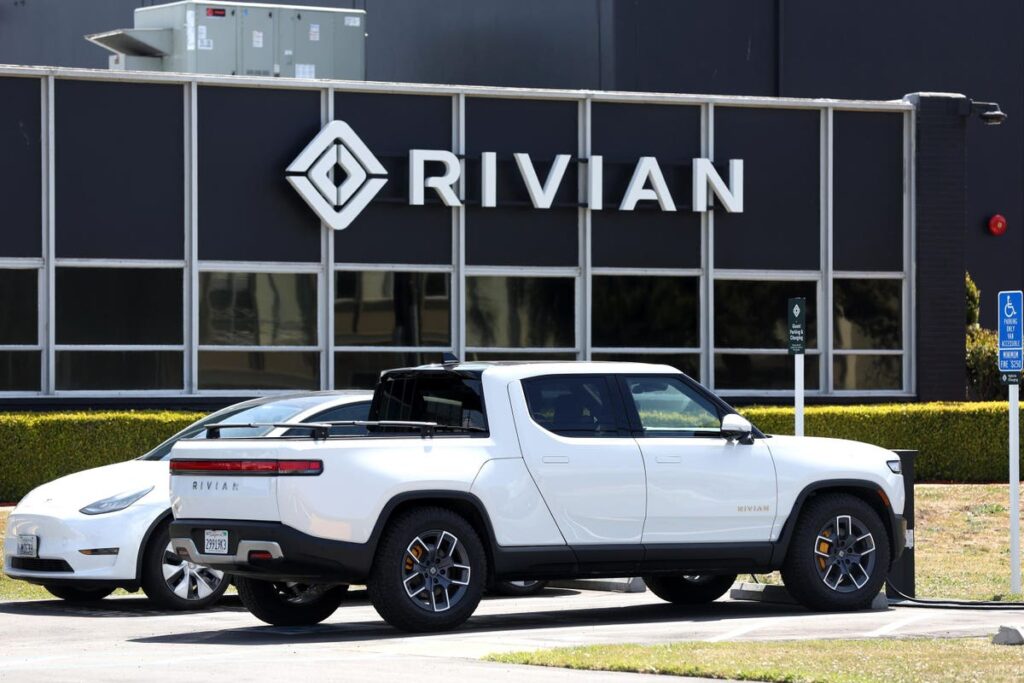Key takeaways
- Rivian has confirmed it’s raising a $1.5 billion convertible green note for institutional investors
- It’s the second time the EV maker has done so in a year to raise cash
- Rivian’s share price fell 23% in a day, a new record drop for the company since its 2021 debut
Start-up EV maker Rivian has announced its intention to issue $1.5 billion worth of convertible green bonds in a move that has sent the company’s share price plunging this week. It didn’t help that the announcement was paired with missed sales estimates for the third quarter, further adding to Rivian’s woes.
The broader EV market is under pressure right now, with price cuts abound across the global market and deliveries falling under target. Rivian is less affected as a truck maker, but investors still have some doubts about the company’s short-term financial future and whether it can turn things around after a slow ramp-up from its 2021 IPO debut.
Let’s get into what’s happening with Rivian’s new convertible stock news, why the EV maker is doing it and how the announcement sparked a big sell-off from Wall Street.
What is Rivian planning with its stock?
According to a new securities filing from the company on Wednesday, EV maker Rivian plans to issue $1.5 billion worth of convertible notes as a private offering to institutional buyers. The document also allowed purchasers to secure an extra $225 million.
Rivian anticipates the bonds will mature in October 2030, from which they can either be converted to cash or shares. Rivian expects the new green bond to “de-risk” its R2 sports utility launch in Georgia.
What’s the big deal? It’s all to do with the stock’s future. Convertible notes are essentially debt that can be turned into shares at a later date, which could dilute shareholders’ existing holdings. Some investors might also short the convertible notes and lock in a ‘bond’ return until the debt is converted into shares.
It’s that potential short interest, and Rivian even needs to issue convertible notes to raise more cash that’s left investors concerned. It’s also the second time in less than a year that Rivian has issued a green bond, having already issued a $1.3 billion one in March to launch its R2 vehicles.
What are Rivian’s latest earnings like?
There was another reason Rivian’s stock fell so severely: the company also issued softer-than-expected guidance, sparking a sell-off among traders. The company issued its third-quarter estimates, with Rivian anticipating sales of $1.29 billion and $1.33 billion. Analyst estimates had Rivian’s third-quarter sales at $1.38 billion.
It wasn’t as bad as it looks: Rivian reported better-than-expected deliveries, arriving at 15,564 for the third quarter ending September 30, which is a 23% lift from the previous quarter. Production was also up to 16,304 EVs in its Illinois facility, up from 13,992 in the second quarter.
The company is still on track to deliver 52,000 EVs in 2023, having already raised that target back in August to 50,000. The company also believed it had cash equivalents and short-term investments of $9.1 billion, which is down from Q2’s $10.2 billion.
It’s not been plain sailing for the EV maker against a difficult economic backdrop and slow adoption of fully electric cars. In August, Rivian said it had delivered 12,640 EVs in the second quarter, totalling revenue of $1.12 billion. The EV maker had a gross loss of $412 million, an operating loss of $1.29 billion and a free cash flow deficit of $1.62 billion.
Even with improved figures in the third quarter, the missed sales estimate and the convertible bond put Wall Street on edge about Rivian’s future viability on Thursday.
Rivian’s CEO, RJ Scaringe, has previously stated the business has enough cash in the bank to keep it going in the short term. “The cash balance that we have today takes us through 2025,” Scaringe said. “We will be very thoughtful and intentional on how we secure additional capital to support the growth of the R2 program.”
What was the market reaction?
Wall Street was clearly aghast at the situation. Rivian’s stock plummeted 23% during Thursday trading, which marked the biggest daily percentage drop in the company’s share price since its market debut in 2021. The shares closed Thursday trading at 22.9%, priced at $18.27, which is the lowest stock price since July.
Thursday’s drop mostly wiped out Rivian’s stock gains for the year, and the company is now up 2.85% since 2023. According to LSEG data, the current median price target from 24 analysts on Rivian shares is $30 with a Buy rating.
EV start-ups have had a rough ride on the markets as a whole. Luxury EV sports car maker Lucid Group has fallen over 64% in value in the last 12 months, while Ford has remained flat (though it doesn’t help that the legacy car maker has a huge union strike going on right now).
Tesla, on the other hand, continues to fly despite price cuts and delivery numbers setbacks. The stock has risen 134% since the year began and is trading for $254.
How is the broader EV market performing?
Rivian’s third quarter estimates are an improvement over the second quarter, but the company has opted against price cuts when its competitors are doing just that. Tesla was the first to do so in the spring, cutting the price of its Model Y and Model 3 by up to 25% in the U.S. so consumers could take advantage of a new EV vehicle tax credit.
Those price drops have extended to the European and Chinese markets, with Tesla, Ford and Volkswagen introducing bargain-basement pricing for their EVs to try and tempt buyers. In comparison, Rivian’s EVs average for $80,000.
Despite the price cut efforts, Tesla’s latest delivery figures for the third quarter disappointed Wall Street. The EV maker delivered 435,059 cars globally in the third quarter, having been hampered by factory shutdowns in the last few months. The slower clip in delivery pace meant that Chinese EV maker BYD overtook Tesla in deliveries for the first time ever, having shipped 440,000 new battery EVs for the quarter ending September 30.
The bottom line
Rivian’s convertible green note might look like a desperate grab for cash to prop up a business haemorrhaging money to some investors or could be seen as a smart move to secure cash now before the market tightens further.
Rivian has struggled to take off since its blockbuster IPO, with the company only producing and delivering tens of thousands of EVs rather than the hundreds of thousands needed to be profitable – because EVs are expensive.
The company’s latest earnings estimates haven’t helped the stock, with Wall Street focusing on Rivian’s dwindling free cash flow and missed sales target. But the quarter’s numbers are still overall an improvement over Q2, which investors should remember when considering putting their money into this EV start-up.
In short, it’s not the end of the world for Rivian, but sales had better continue looking relatively strong over the next couple of quarters to allay Wall Street’s concerns.
Read the full article here













